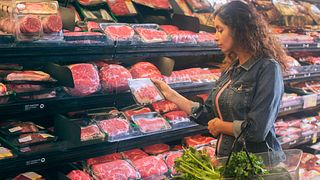understanding beef safety
Beef has long been America’s favorite protein and rightfully so as it delivers great flavor and powerful nutrition. The following tips will provide proper safe handling guidance, proper cooking instructions and storage of cuts and leftovers.
USDA recommends the following guidance for safe cooking:
Product |
Minimum Internal Temperature & Rest Time |
|---|---|
| Beef Steaks, Roasts | 145°F and allow to rest for at least 3 minutes |
| Ground Meats | 160°F |
| Leftovers | 165°F |
| Casseroles | 165°F |
- When shopping, pick up beef just before checking out. If it will take longer than 30 minutes to get it home, consider keeping it cold in a cooler.
- Refrigerate or freeze as soon as possible after purchasing.
- If you plan to freeze your beef, think ahead to your weekly meals and re-package into right-size portions for you and your family.
- You can freeze beef in its original packaging up to two weeks. For longer storage, wrap in heavy-duty aluminum foil or place in plastic freezer bags, removing as much air as possible.
- Place beef packages on the lowest shelf in your refrigerator on a plate or tray to catch any juices.
- Label each package with the date, name of beef cut and weight and/or number of servings. Practice the FIFO (first in, first out) inventory system.
- Refrigerate leftovers within 2 hours after cooking.
- Ground Beef is more perishable than roasts or steaks. Plan to use refrigerated Ground Beef within 1 to 2 days of purchase.

Refrigerator and Freezer Guidelines
Different beef cuts can determine the amount of time it can safely be stored in the refrigerator or freezer.

Defrosting Guidelines
For best quality, defrost beef in the refrigerator, never at room temperature. Place frozen package on a plate or tray to catch any juices and place in the refrigerator.
To avoid cross-contamination and prevent foodborne illnesses, follow these easy steps:
- Wash hands well in hot, soapy water before and after handling raw meat and other fresh foods. Inadequate handwashing is a contributing factor to all sorts of illness, including foodborne illness. It is important to follow proper handwashing steps before, during and after preparing raw and frozen food to prevent germs from transferring from your hands to your meal.
- Keep raw meat and meat juices away from other foods, both in the refrigerator and during preparation.
- Wash all utensils, cutting surfaces and counters with hot, soapy water after contact with raw meat.
- Keep carving boards separate from other food preparation areas and serving platters.
- Use a gentle touch with Ground Beef. Over-mixing will result in burgers, meatballs or meatloaves with a firm, compact texture.
- Before cooking, pat steaks and roasts dry with paper towels for better browning.
- When stir-frying, partially freeze steaks for about 30 minutes for easier slicing.
- When roasting or broiling, place steaks or roasts on a rack in a roasting or broiler pan to allow fat to drip away during cooking.
- For kabobs, cut steak into uniform pieces to ensure even cooking. Pieces do not need to be absolutely square – some may have rounded or uneven edges.
- Thread steak pieces onto skewers leaving small spaces between them. Loose or tight spacing can cause beef to cook unevenly.
- Even with frozen beef products, it is important to handle it similar to raw products. Wash your hands after handling and use a food thermometer to make sure it reaches a safe internal temperature.
- Use the pan size specified in the recipe. If the pan is too small, the beef will be crowded and browning will be inhibited. If the pan is too large, overcooking may result.
- Choose heavy, good-quality pans that are thick enough to heat evenly without scorching.
- Nonstick pans are easier to clean and allow for cooking with little or no added fat. Best results are achieved over medium heat with nonstick pans.
- When cooking with acidic ingredients, such as tomatoes, citrus juices or wine, use pans with a nonreactive interior surface such as nonstick, anodized aluminum or stainless steel. Reactive metals such as aluminum and cast iron can affect the taste and color of dishes with acidic ingredients.
- High heat can overcook or char the outside of beef cuts while the interior remains underdone.
- There is no need to bring beef to room temperature before cooking—straight from the refrigerator works effectively.
- Turn steaks and roasts with tongs. Avoid using a fork, which will pierce the beef and result in the loss of flavorful juices.
- Turn Ground Beef patties with a spatula. Do not press down on the patty, or flavorful juices will be lost, resulting in a dry burger.
- Salt beef after cooking or browning. Salting beef before cooking draws out moisture and restricts the flavor that browning imparts.







